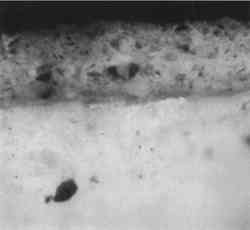EVIDENCE OF REPLICATION IN A PORTRAIT OF ELEONORA OF TOLEDO BY AGNOLO BRONZINO AND WORKSHOPSERENA URRY
3 MATERIAL EVIDENCEThe material evidence primarily addresses the date of the Detroit portrait. It appears to be contemporary with the Uffizi portrait. The panel's material, construction, and condition are typical of 16th-century Italian painting. The paint displays the crackle and patina characteristic of a painting of this age. No nonperiod pigments were found. The most visible material difference between the two portraits is the background color. The background of the Uffizi portrait is a rich deep blue. Conservation records from 1960 in the Opificio delle Pietre Dure in Florence list the pigment as ultramarine, though there is no indication of analysis having been performed. It certainly appears to be true ultramarine. In fact, one scholar has recently linked a letter from Bronzino to the Uffizi portrait. The letter, written in the summer of 1545, is to Riccio, Cosimo de'Medici's majordomo. Bronzino is painting a In contrast to the Uffizi portrait, the background of the Detroit portrait is a gray green. The paint is extremely degraded. The medium has discolored to a light brown, and the pigment seems only to exist as discrete islands in the degraded medium. Severe traction crackle presents a leathery texture, which is particularly evident in the dark areas. At the top edge of the painting, where the rabbet has protected the paint, a less degraded area shows that the background had been blue (fig. 3). After cleaning, a previous repair to the panel at the upper right corner was exposed. The surface of the painting had been planed, and a layer of lavender pigment was revealed under the originally blue background. The blue and the lavender were identified by x-ray fluorescence and polarizing light microscopy. The upper layer is smalt mixed with lead white, and the lower is a red lake mixed with lead white. A cross section taken from a light area of the background shows the layering and the darkening of the degraded medium at the top of the sample (fig. 4). The degradation of the background paint is noticeably less advanced in areas where more lead white is present.
The background of the Detroit portrait is a textbook example of degraded smalt, the pigment discoloring to “a curiously unpleasant greyish green, slightly mottled with brown” (Plesters 1969, 65). The smalt, known to have been used in 16th-century Italian painting, has aged in the Detroit portrait over a significant period. It is clear, however, that the initial layering of cool pale blue smalt on lavender was a deliberate attempt to mimic the deep rich blue background of the Uffizi portrait without going to the expense of true ultramarine. Thus the Detroit picture is literally less valuable in terms of the costs of the pigments, which supports the idea that it is a copy of the more expensive Uffizi portrait. Another difference in color is found in Don Giovanni's costume. In the Uffizi portrait it is a rich violet shot with gold highlights. In the Detroit portrait the costume now appears as a light brown shot with gold. Initial analysis by x-ray fluorescence of the brown and gold suggests the presence of smalt and vermilion, along with lead-tin yellow and earth pigments. If the gold |

